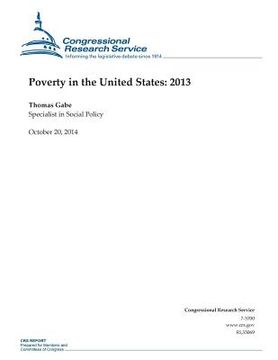Synopsis "Poverty in the United States: 2013 (in English)"
In 2013, 45.3 million people were counted as poor in the United States under the official poverty measure-a number statistically unchanged from the 46.5 million people estimated as poor in 2012. The poverty rate, or percent of the population considered poor under the official definition, was reported at 14.5% in 2013, a statistically significant drop from the estimated 15.0% in 2012. Poverty in the United States increased markedly over the 2007-2010 period, in tandem with the economic recession (officially marked as running from December 2007 to June 2009), and remained unchanged at a post-recession high for three years (15.1% in 2010, and 15.0% in both 2011 and 2012). The 2013 poverty rate of 14.5% remains above a 2006 pre-recession low of 12.3%, and well above an historic low rate of 11.3% attained in 2000 (a rate statistically tied with a previous low of 11.1% in 1973). The incidence of poverty varies widely across the population according to age, education, labor force attachment, family living arrangements, and area of residence, among other factors. Under the official poverty definition, an average family of four was considered poor in 2013 if its pre-tax cash income for the year was below $23,834. The measure of poverty currently in use was developed some 50 years ago, and was adopted as the "official" U.S. statistical measure of poverty in 1969. Except for minor technical changes, and adjustments for price changes in the economy, the "poverty line" (i.e., the income thresholds by which families or individuals with incomes that fall below are deemed to be poor) is the same as that developed nearly a half century ago, reflecting a notion of economic need based on living standards that prevailed in the mid-1950s. Moreover, poverty as it is currently measured only counts families' and individuals' pre-tax money income against the poverty line in determining whether or not they are poor. In-kind benefits, such as benefits under the Supplemental Nutrition Assistance Program (SNAP, formerly named the Food Stamp program) and housing assistance, are not accounted for under the "official" poverty definition, nor are the effects of taxes or tax credits, such as the Earned Income Tax Credit (EITC) or Child Tax Credit (CTC). In this sense, the "official" measure fails to capture the effects of a variety of programs and policies specifically designed to address income poverty. A congressionally commissioned study conducted by a National Academy of Sciences (NAS) panel of experts recommended, some 20 years ago, that a new U.S. poverty measure be developed, offering a number of specific recommendations. The Census Bureau, in partnership with the Bureau of Labor Statistics (BLS), has developed a Supplemental Poverty Measure (SPM) designed to implement many of the NAS panel recommendations. The SPM is to be considered a "research" measure, to supplement the "official" poverty measure. Guided by new research, the Census Bureau and BLS intend to improve the SPM over time. The "official" statistical poverty measure will continue to be used by programs that use it as the basis for allocating funds under formula and matching grant programs. The Department of Health and Human Services (HHS) will continue to issue poverty income guidelines derived from "official" Census Bureau poverty thresholds. HHS poverty guidelines are used in determining individual and family income eligibility under a number of federal and state programs. Estimates from the SPM differ from the "official" poverty measure and are presented in a final section of this report.

